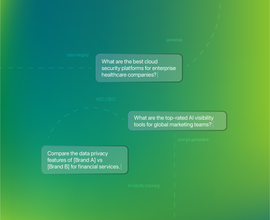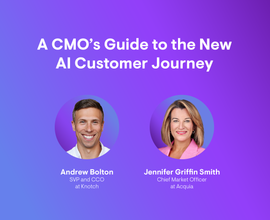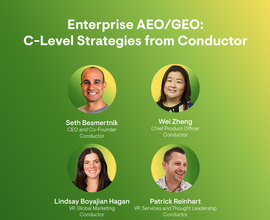The Best AI Visibility Platforms: Evaluation Guide
AI answer engines like ChatGPT, Perplexity, and Google's AI Overviews and AI Mode are changing how customers discover brands. While user adoption of these tools in daily behavior is rising fast, most companies are flying blind when it comes to tracking their visibility in LLMs. The right platform can show you exactly how your brand appears in AI-generated responses and help you optimize for more mentions, citations, and, ultimately, higher AI referral traffic.
The challenge? Not all platforms are created equal.
With dozens of AI visibility platforms and startups claiming to be the best, we've done the heavy lifting for you. We'll walk you through the must-have features and evaluation criteria that separate the leaders from the rest, and we’ll rank the top tools on the market overall, for enterprise, and SMBs.
TL;DR
We evaluated dozens of AI visibility platforms using nine core criteria, from API-based data collection to enterprise scalability. AI visibility is moving fast, and only a handful of platforms deliver the depth, reliability, and actionable insights needed to actually improve your performance—not just track it. Here are the winners:
Overall Leaders:
- Conductor
- Profound
- Peec AI
- Geneo
- Rankscale
- Athena
- Scrunch AI
Enterprise Winner: Conductor
SMB Winner: Geneo
Ready to see how we got here? Keep reading for our complete methodology, detailed evaluation criteria, and everything you need to know to choose the right AI visibility platform for your business.
Your guide to the best AI visibility tools
AI engines like ChatGPT and Perplexity now handle 2.5 billion daily prompts , and users no longer need to click links to get answers. That means if your brand isn't part of the answer, it's not part of the conversation. With AI search accelerating this fast, staying visible isn't optional—it's survival.
Unlike traditional SEO, where you optimize for rankingsRankings
Rankings in SEO refers to a website’s position in the search engine results page.
Learn more, AI visibility requires a completely different approach. You're optimizing for inclusion in a near-infinite number of potential AI-generated answers, either in the form of website citations or brand mentions, instead of chasing the top ten blue links on Google’s SERP.
So, how do you track and measure your AI visibility in LLMs in a world where there are endless sets of prompts and AI-generated responses? That's where AI visibility platforms come in, promising to help you track and improve your AI presence.
But here's the thing: most AI visibility platforms are still figuring it out themselves.
Some offer basic monitoring, others promise optimization they can't deliver. The key is knowing which features matter and which are just marketing fluff.
That's exactly what we'll help you figure out in this guide. We'll break down how AI visibility platforms work, the evaluation criteria that matter, and which platform is right for you.
What is an AI visibility platform?
Before we start evaluating platforms, let's back it up and define what we're talking about. AI visibility tools refer to how prominently your brand appears in AI-generated responses from engines like ChatGPT, Perplexity, Gemini, and Google's AI ModeAI Mode
AI mode is a search feature using AI to provide comprehensive answers by synthesizing information from multiple sources into direct responses.
Learn more and AI Overviews. These don't just serve up search results; they combine information from multiple sources to create direct answers.
Here's what this looks like in practice:
- Traditional search: User searches "Best CRM software" → sees ranked list of websites → clicks through multiple sites to compare options and find their answer
- AI search: User asks an answer engine: "What CRM should I use for my small business?" → gets a direct AI-generated answer with specific recommendations → follows through with the AI's top suggestion, often visiting just that one website
AI visibility platforms tackle this head-on, monitoring, analyzing, and optimizing your brand's presence in AI-generated responses.
Here's why this matters more than traditional metrics: AI search is rapidly becoming the dominant way people find information, and growth is only possible when you measure and optimize your visibility across these AI-driven search engines.
While SEO tools show you where you rank in traditional search, AI visibility platforms reveal how AI engines actually present your brand to users in this new landscape. They track whether you're mentioned positively, negatively, or ignored entirely when people ask questions in your space—insights that traditional rankings alone can't provide.
No AI visibility means no traffic, no engagement, and ultimately, business decline.
Want to dive deeper into AI visibility? Check out our complete guide to AI visibility for more insights.
How AI visibility platforms work
AI visibility platforms work through answer engine optimization (AEO), but how they gather this intelligence varies dramatically, and it matters more than you might think.
These platforms constantly query AI engines with thousands of questions related to your industry, tracking when and how your brand appears in responses. When your brand shows up, they analyze the context: Are you the recommended solution or just mentioned in passing? Which content pieces are influencing AI engines?
This is where it gets critical: there are two fundamentally different approaches to collecting this data, and the method determines the quality and reliability of your insights.
API-based monitoring connects directly to AI engine sources (platforms like OpenAI, Google, and others) to get real-time data straight from the source. This approach requires significant investment, as platforms pay premium fees for direct access, but delivers accurate, reliable data that AI companies approve of.
Scraping-based monitoring simulates user interactions and crawls AI-generated responses without permission from the AI companies. While cheaper to implement, this approach resembles "black hat" tactics that LLM providers actively discourage. The data can be inconsistent, and there's always a risk that access could be blocked.
Why do some platforms rely on scraping instead of legitimate APIs?
The answer is simple: cost. Scraping-based platforms avoid the substantial partnership fees and API costs required for direct access to AI engines. Instead of investing in proper data partnerships with companies like OpenAI and Google, these platforms take shortcuts by essentially stealing data through unauthorized scraping methods.
This allows them to offer cheaper solutions, but at the expense of data quality, reliability, and ethical business practices.
The difference isn't just technical; it's about data integrity. API-based platforms provide the confidence that what you're seeing reflects actual AI behavior, while scraped data introduces uncertainty about whether you're optimizing for real patterns or data artifacts.
With the right AI visibility platform, you get a complete picture of your AI presence that traditional SEO tools can't provide. More importantly, you get reliable insights to optimize your content for AI-powered search.
Key metrics in AI visibility
Once you understand how these platforms work, you need to know what they're measuring. AEO tools track several key metrics that tell you not just if you're visible, but how well you're performing compared to competitors:
- Mentions: How often your brand gets referenced in AI responses across different queries (may or may not include a link to your site)
- Citations: When and how often AI engines explicitly reference your website as a source (typically includes a link to your site)
- Share of voice: Your percentage of visibility compared to competitors (based on mentions, citations, or both, depending on how you configure the report)
- Sentiment: The tone of AI-generated content about your brand
- Content readiness: Whether your site's content is optimized for AI engines
These metrics work together to give you a complete picture of your AI search engineSearch Engine
A search engine is a website through which users can search internet content.
Learn more performance and clear direction on where to focus your optimization efforts.
Essential evaluation criteria for AI visibility tools
Now, let’s talk criteria. We know that every organization is different. What matters most will depend on your specific goals, existing tech stack, budget, and team size. That said, there are nine core features that should be on everyone’s must-have list.
All-in-one platform
The platform integrates visibility measurement, content optimization, and performance monitoring in one unified workflow. Managing multiple point solutions creates incomplete visibility and forces teams to waste time manually reconciling data discrepancies across dashboards. More importantly, you can't action the AI visibility insights you get from standalone tools. You see where your brand appears, but have no way to optimize within the same platform.
That’s why it’s important to choose a platform that provides an end-to-end, coordinated view of your AI visibility strategy in one place, where insights directly inform optimization actions.
API-based data collection
The platform uses API-based data collection rather than scraping approaches. API-based methods provide more reliable, accurate insights that AI companies approve of and eliminate the risk of data access being blocked or restricted.
Comprehensive AI engine coverage
The platform can track your brand across all major AI engines, including ChatGPT, Perplexity, Google's AI Overviews, and other leading LLMs. Different AI models draw from different data sources and prioritize information differently, making comprehensive coverage essential for complete visibility.
Actionable optimization insights
The platform provides specific, data-driven recommendations for content strategy, topic gap analysis, and new content creation to improve your AI search visibility. The best platforms identify content gaps to build topic authority where you're underrepresented instead of just reporting problems and leaving you stranded. Choose platforms that bridge the gap between insights and action.
LLM crawl monitoring
The platform can track whether AI bots from major language models are actually crawling your content. Unlike traditional search crawlersCrawlers
A crawler is a program used by search engines to collect data from the internet.
Learn more, AI engines use different bots with varying access patterns. If AI bots aren't crawling your site, your content won't appear in AI-generated responses, making all your AEO efforts worthless.
Without dedicated monitoring, you have no visibility into whether your high-value content is even accessible to the AI engines you're trying to optimize for.
Attribution modeling and traffic impact
The platform can connect AI mentions to measurable business outcomes like website traffic, conversions, and revenue. This capability is essential for measuring ROI and demonstrating value to stakeholders.
Competitor benchmarking
The platform can show your AI share of voice compared to competitors and identify content gaps in your industry's AI conversation. This competitive intelligence directly informs your content strategy and market positioning.
Integration capabilities
The platform integrates seamlessly with your existing marketing stack, including CMS platforms, analytics tools, and business intelligence solutions. Standalone AI visibility platforms often create data silos, requiring expensive custom integrations or forcing teams to manually correlate insights across multiple dashboards.
Enterprise scalability
The platform offers robust user management, custom reporting, API access, and can handle large data volumes as your organization grows. These capabilities become critical requirements for enterprise-level AI visibility programs.
So, how do you evaluate platforms against these criteria? Here's the approach we used to determine the best AI visibility platforms available today.
Methodology: How we determined the best platforms
We didn't just throw together a list of platforms and call it a day. Our evaluation process combined multiple sources to give you the most accurate picture of what's actually working in the market right now.
Who better to ask about AI than AI itself? First, we asked ChatGPT which AI visibility platforms it recommends. We also consulted other leading AI engines to cross-reference their recommendations and identify platforms that consistently appeared across multiple AI responses.
Then we layered in Conductor's own data and years of experience helping enterprise brands master their search and digital visibility strategies. This includes analyzing performance patterns from our customer base, tracking which platforms deliver measurable improvements in AI mention frequency and citation quality, and identifying the technical capabilities that matter for enterprise-scale AI visibility optimization.
Here's what we kept coming back to: the best platforms don't just track your AI visibility—they help you improve it. Monitoring is nice to have, but actionable optimization insights based on that monitoring data are what truly matter.
This is why we prioritized all-in-one platforms that unify measurement and optimization in a single workflow.
The difference between knowing you have a problem and being able to fix it comes down to whether the platform can translate visibility metrics into specific, data-driven recommendations for content strategy, technical improvements, and competitive positioning.
The best AI visibility tools: Overall leaders
Based on our evaluation criteria, these seven platforms stand out as the top performers in the AI visibility space. And before you ask: we promise we didn't pay ChatGPT to rank us #1. We tasked it with providing its own unfiltered recommendations (but we're thrilled with the results).
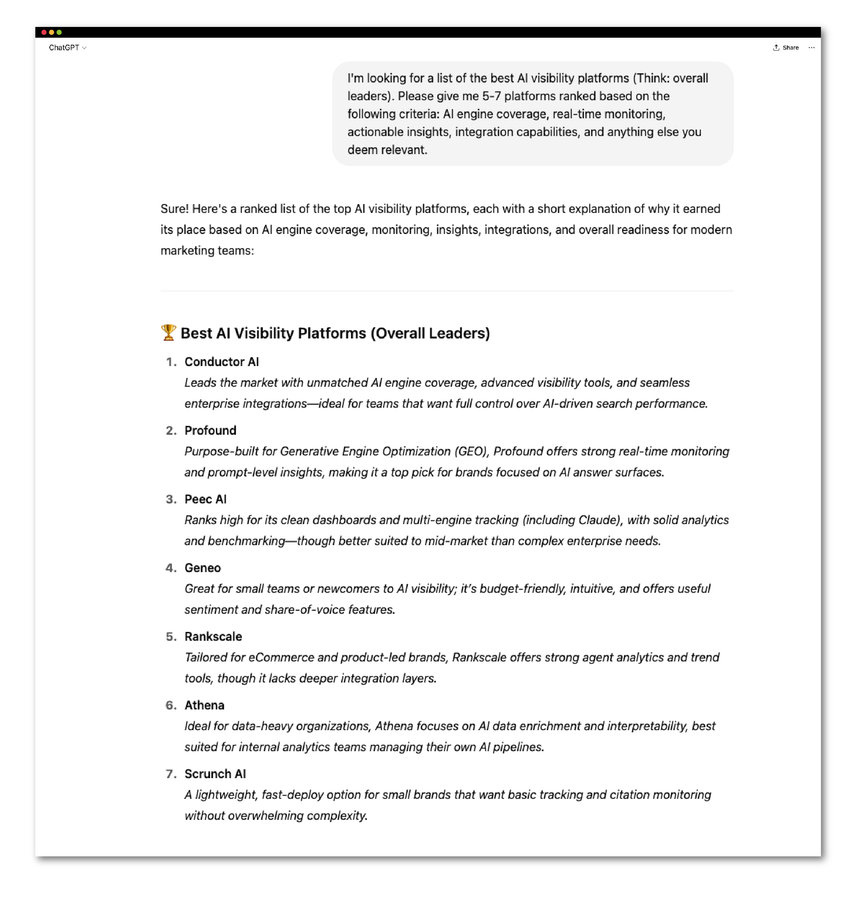
What separates these leaders from the pack? They've moved beyond basic mention counting to offer genuine technical depth and strategic value. We're talking API-based data collection for reliability, advanced analytics that provide actionable insights, and optimization features that help you act on what you learn.
1. Conductor
- AI engine compatibility: ChatGPT, Perplexity, Google AI Overviews, and Google AI Only Mode, with more AI engines coming soon
- Pros:
- Only platform delivering on all nine core criteria with true end-to-end integration of AI visibility, SEO/AEO, and content workflows.
- API-based data collection
- Proprietary AI Topic Maps
- Instant workflow connections to Creator
- LLM/AI bot crawling
- Enterprise-grade capabilities that connect AI mentions to actual business outcomes
- Cons: Enterprise pricing might be higher than standalone AI visibility tools
- Criteria coverage: 9 out of 9
We know we're biased, but ChatGPT agrees: we really are the best.
Conductor bridges the gap between traditional SEO and AEO/AI visibility with an integrated approach that other platforms can't match. Instead of treating AI visibility as a separate silo, it weaves AI insights directly into your existing content and SEO workflows, from initial research through optimization and performance monitoring.
The platform's unified data model combines 10+ years of search performance data with real-time AI visibility tracking. This means you're not just seeing where you appear in AI responses, you're understanding how those appearances connect to your broader content strategy and business outcomes.
Conductor takes this process even further with features like AI Topic Maps and AI Search Performance that show you the bigger picture of where your brand fits in the conversation.
AI Topic Maps uses our proprietary AI engine to map how LLMs see your website, revealing exactly where to create or optimize content for the biggest impact.
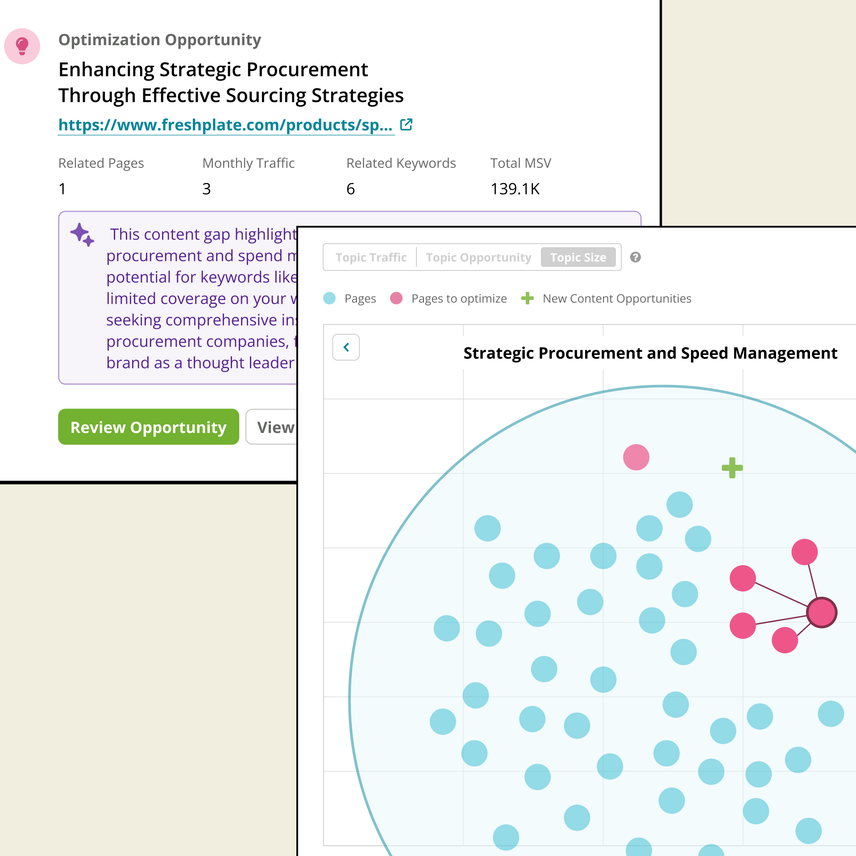
AI Search Performance tracks how often your brand is surfaced versus competitors in AI answers, helping you understand who's winning which topics and where to focus your content efforts.
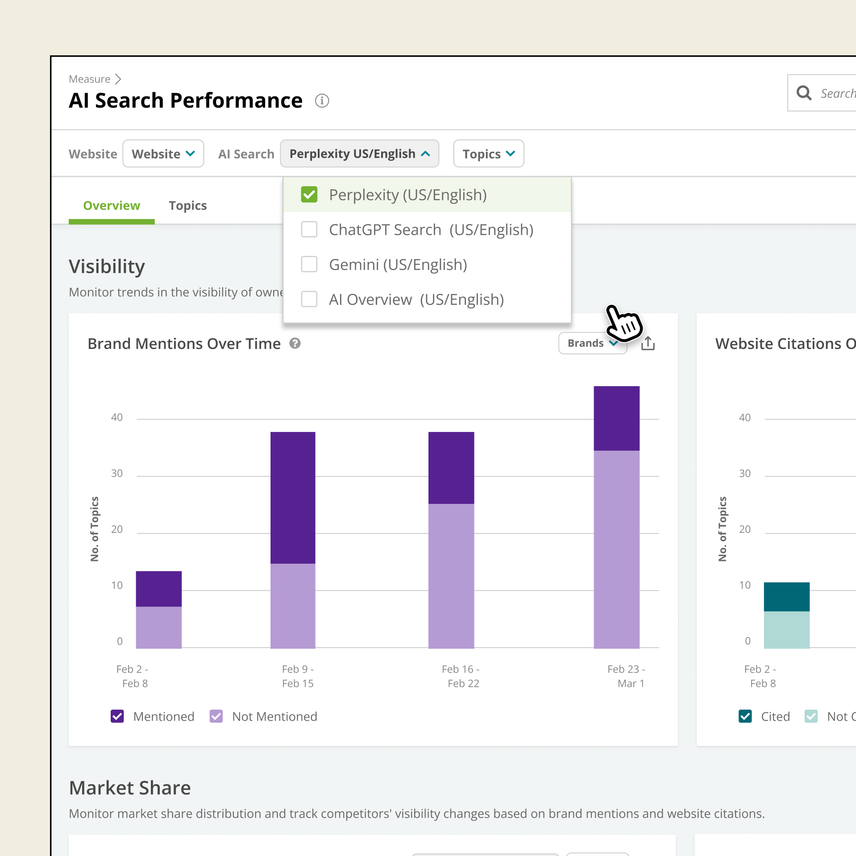
Unlike tools that leave you wondering what to do next, Conductor shows you why an opportunity matters and then instantly kick-starts your writing workflow, connecting strategy to execution in Creator. This is the difference between knowing you have a visibility problem and being able to solve it.
Plus, it uses advanced monitoring that tracks how AI engines read and interpret your content. Then, the AI Writing Assistant and content guidance features give you actionable recommendations to improve your content for increased visibility on AI engines.
All of this gets rolled into custom, shareable dashboards that don't just show you data, they show you what to do about it.
2. Profound
- AI engine compatibility: ChatGPT, Perplexity, Google AI Overviews, and other major LLMs
- Pros:
- Singular focus on AI visibility
- Strong sentiment and attribution tracking
- Granular keyword-level analysis
- Cons:
- Lacks optimization guidance, broader integrations, and unified data
- Legacy keyword-focused approach misses strategic topic clustering that drives modern AI search success
- Relies on web scraping over official APIs.
- Criteria coverage: 4 out of 9
Profound is all about AI visibility (and nothing else), focusing on granular keyword-level tracking rather than strategic topic insights. They excel at detailed prominence scoring, sentiment analysis, and source attribution. Their reverse-engineering analysis traces AI responses back to your original content, so you know exactly which pieces are driving mentions and how individual keywords perform.
However, unlike platforms that use API-based data collection for more reliable and approved insights, Profound still relies on UI scraping rather than official partnerships with AI engines, introducing potential data reliability and access risks.
This is also where platforms that only focus on AI visibility hit their limits. Profound is great at reporting problems, but leaves you to solve them on your own. You’ll need other tools for optimization, technical fixes, and measuring business impact, which can create data fragmentation and slow down workflows.
Without end-to-end workflow integration, you're essentially paying for expensive monitoring with no clear path to improvement.
Profound ranks high because we're evaluating AI visibility platforms, and it delivers excellent standalone visibility tracking. While it meets fewer of our core evaluation criteria than some competitors, its unmatched depth in AI-specific analysis and prominence tracking keeps it ranked second for teams that prioritize the most granular visibility data available.
But there's a reason they're ranked below Conductor: monitoring without actionable optimization only gets you halfway to success.
3. Peec AI
- AI engine compatibility: ChatGPT, Perplexity, Claude, and Gemini
- Pros: Super user-friendly, cuts through complexity, great for getting started, intelligent opportunity ranking
- Cons: Covers six of nine evaluation criteria, might feel limiting if you want to dive deep into the data, and lacks technical crawl validation
- Criteria coverage: 6 out of 9
If you're intimidated by the complexity of AI visibility tracking, Peec AI is here to make your life easier. It tracks brand mentions across AI engines with simplified reporting that highlights the most important trends and opportunities you can act on.
The platform focuses on making AI visibility data actionable rather than overwhelming you with every possible metric. Its smart prioritization system ranks opportunities by ROI potential, so you know where to focus first.
Peec AI ranks third because its strength lies in user-friendly tracking and smart opportunity prioritization, which makes AI visibility accessible to any team. The platform's beginner-focused design intentionally sacrifices depth of data analysis and technical monitoring capabilities that advanced SEO teams need for sophisticated AEO strategies.
Teams looking to scale beyond basic AI visibility tracking will quickly outgrow its simplified feature set.
4. Geneo
- AI engine compatibility: ChatGPT, Google AI Overviews, Perplexity
- Pros: Easy to understand, good for teams just getting started, won't break the bank, direct API connections
- Cons: Lacks optimization and attribution features, no deep integration capabilities
- Criteria coverage: 4 out of 9
Geneo keeps things straightforward. It has solid AI visibility tracking with none of the bells and whistles that might confuse your team. You get what you need to understand your AI presence and track competitive positioning without paying for features you'll never use.
The platform uses reliable API connections and includes competitive share-of-voice tracking to show whether you're gaining ground over time. Sometimes, simple is exactly what you need.
Geneo earns its fourth-place ranking because it delivers reliable, straightforward AI visibility tracking at an accessible price point. However, the platform's deliberately simple approach means it lacks the optimization guidance and attribution modeling that teams need to improve their AI performance.
While you'll know where you stand competitively, you won't get actionable insights on how to climb higher, making it better suited for monitoring than strategic improvement.
5. Rankscale
- AI engine compatibility: ChatGPT, Google AI Overviews, Perplexity, and Gemini coming soon
- Pros: Shows the bigger picture, competitive pricing, multi-channel insights, and integrated analytics
- Cons: Covers six of nine evaluation criteria, lacks precision features for visibility improvement, limited optimization capabilities
- Criteria coverage: 6 out of 9
Rankscale takes a different approach by showing you how AI visibility fits into your bigger marketing picture. Instead of treating AI visibility as a standalone metric, it helps you understand how it connects to your other digital marketing efforts.
This integrated view can be really valuable if you're trying to understand the broader impact. Their cross-channel analytics show correlations between AI mentions and your search, social, and website performance.
Rankscale brings a valuable cross-channel perspective by connecting AI visibility to broader marketing performance with competitive pricing. But this integrated marketing approach comes with a trade-off: less precision in AI-specific optimization.
You'll understand how AI mentions correlate with other marketing efforts, but won't get the granular, AI-focused guidance needed to systematically improve performance in individual engines, placing it fifth on our list.
6. Athena
- AI engine compatibility: ChatGPT, Perplexity, Google AI Overviews, and other major LLMs
- Pros: Comprehensive brand monitoring, crisis management features, enterprise-grade everything, pattern detection algorithms
- Cons: Covers six of nine evaluation criteria, might be overkill if you only care about AI visibility, less actionable for SEO/content teams
- Criteria coverage: 6 out of 9
Athena is essentially brand monitoring on steroids, extended to include AI-generated contentAI-Generated Content
AI-generated content is text, images, or designs produced by AI systems based on human inputs that mimic human writing style.
Learn more. Its standout feature is sophisticated sentiment analysis and crisis management capabilities. This platform isn’t only tracking mentions, it's helping you respond to potential reputation issues before they become real problems, which is especially important for more at-risk industries like healthcare, financial services, and pharmaceuticals.
Its smart detection algorithms also spot unusual patterns that might signal trouble, with automated workflows that route alerts to the right team members.
Athena ranks sixth because it brings enterprise-grade brand monitoring expertise to AI visibility with exceptional crisis management features. However, the platform is designed for brand protection rather than content optimization, making it less actionable for teams focused on improving AI search performance.
7. Scrunch AI
- AI engine compatibility: ChatGPT, Google AI Overviews, Perplexity, and other leading LLMs
- Pros: Strong content optimization focus, actionable recommendations, great for content teams, provides proven templates based on successful patterns
- Cons: Covers five of nine evaluation criteria, smaller platform with potentially limited support, limited monitoring and reporting capabilities
- Criteria coverage: 5 out of 9
Scrunch AI is all about helping you improve your content for AI search. Instead of just telling you how you're performing, it gives you specific guidance on how to structure content that performs better in AI search results. It's like having a content strategist who specializes in AI optimization.
The platform analyzes successful AI citations to identify content patterns, then provides templated frameworks and specific recommendations for different content types.
Scrunch AI prioritizes actionable content optimization over comprehensive monitoring, making it a favorite among content teams seeking specific improvement guidance. But its optimization-first design creates a significant blind spot in performance measurement.
Teams get excellent recommendations on what to create, but limited insights into whether those efforts are actually working or how to adjust strategy based on results, placing Scrunch AI at seventh.
Here’s a breakdown of each AI visibility platform and the criteria they score for:
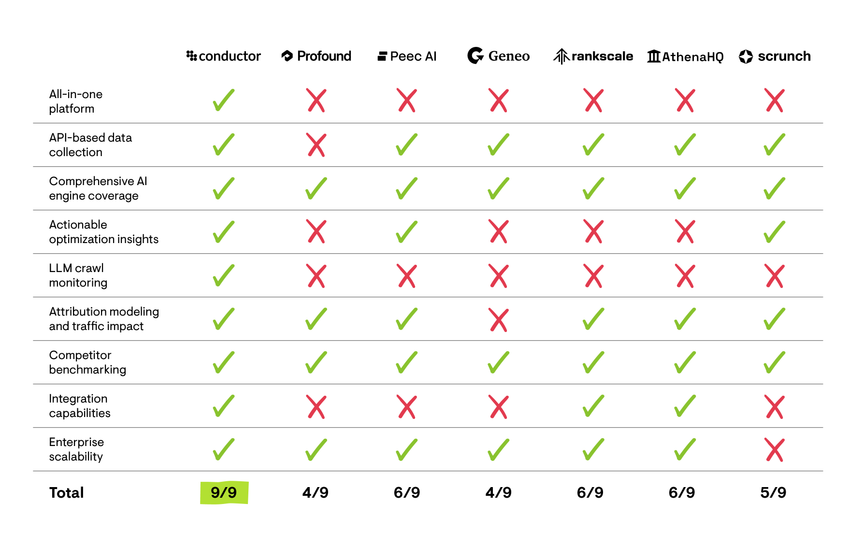
The best AI visibility tools for enterprise
When you're managing AI visibility at enterprise scale, you need a platform that can handle it. We evaluated these AEO/GEO tools specifically on their ability to scale across massive keywordKeyword
A keyword is what users write into a search engine when they want to find something specific.
Learn more sets, integrate seamlessly with enterprise systems through robust APIs, and provide the kind of granular user management and custom reporting that enterprise teams rely on.
Here are the three that delivered exactly that, ranked from strongest to weakest for enterprise deployment.
1. Conductor
- Enterprise AI visibility features:
- Multi-domain tracking across hundreds of brands
- Enterprise-grade security with SOC 2 Type 2 certification plus GDPR compliance, Single Sign-On (SSO), and role-based permissions
- Unlimited users at no extra cost
- Custom reporting hierarchies for C-level executives and all other role levels
- Pros:
- Only platform combining AI visibility with enterprise SEO and content workflows
- Handles massive keyword sets with real-time monitoring
- Dedicated customer success for AI visibility strategy
- Integrates with your full tech stack, from CMS platforms like Adobe Experience Manager to analytics tools and BI solutions
- Cons: Premium pricing reflects enterprise-grade capabilities
Conductor handles the chaos of enterprise marketing, especially when it comes to AI visibility at scale. You get role-based access controls, seamless integration with systems like Adobe Experience Manager, and dedicated account management that understands your business. It's the difference between having a platform and having a strategic partner.
Unlike point solutions like Profound that force you to stitch together insights across disconnected tools, Conductor's AI visibility integrates directly with content creation and SEO workflows, eliminating data silos and enabling coordinated optimization at scale across multiple domains and teams. Real integration beats pieced-together solutions every time—that’s why we’re #1.
2. Profound
- Enterprise AI visibility features:
- Advanced user management
- Custom reporting hierarchies
- Specialized consulting support
- Pros:
- Detailed enterprise reporting
- Specialized consulting support
- Deep AI-specific analytics with prominence scoring
- Cons:
- Relies on web scraping, creating data reliability risks
- Requires separate tools for optimization, creating data fragmentation across enterprise workflows
- Pay-per-user licensing limits collaboration
Profound gives enterprise teams granular control over thousands of keywords and entities. Custom dashboards show executives exactly what they want to see, with detailed reporting that can be configured for different organizational needs. Plus, their specialized consultants understand enterprise-level complexity and compliance requirements.
This platform ranks second for enterprise because while it's excellent at showing you problems, it leaves you to figure out the solutions on your own. It lacks the integrated optimization capabilities enterprises need to act on insights across multiple teams and workflows. The result? You’re forced to coordinate between platforms manually, creating data silos that slow down enterprise marketing operations. Plus, it lacks the API-based data collection needed for reliability and trust.
3. Athena
- Enterprise AI visibility features:
- Multi-brand monitoring dashboards
- Automated crisis workflows
- Detailed audit trails for compliance
- Cross-regional language support
- Pros:
- Exceptional crisis management
- Handles complex organizational structures
- Strong compliance features
- Sophisticated pattern detection algorithms
- Cons:
- Focused on brand protection rather than content optimization
- Limited actionable insights for improving AI visibility
- Less integration with content workflows
Athena handles comprehensive brand monitoring across multiple brands, regions, and languages. Crisis management workflows automatically route issues to the right teams based on severity. It's particularly strong for regulated industries that need detailed audit trails and sophisticated alerting.
Athena gets our third-place ranking because while it excels at protecting your brand reputation across AI platforms, it won't help you win more AI mentions or optimize content to dominate the conversation. If you want to play defense instead of scoring points, this is your platform.
Not sure which AI visibility platform is right for you? See how Conductor compares to every major competitor in our comprehensive tool comparison.
The best AI visibility tools for SMBs
If you're a small business, individual marketer, or just getting started with AEO/GEO solutions, you likely don't need (or want) enterprise complexity. We evaluated these platforms based on their ease of setup, intuitive interfaces, affordability, and ability to deliver clear insights without requiring a team of specialists to interpret the data.
These platforms are designed for teams that want to understand their baseline AI search presence without becoming AI visibility experts.
1. Geneo
- Pros:
- Most affordable option on our list
- API-based data collection
- Competitive share-of-voice tracking
- Cons:
- Only covers four of nine evaluation criteria
- Lacks optimization guidance
- No technical monitoring
Geneo offers straightforward AI visibility tracking with a clean interface that doesn't overwhelm you with unnecessary features. It's perfect for small teams that want solid data on their AI presence without paying for enterprise bells and whistles they'll never use.
2. Goodie AI
- Pros:
- Fastest setup time
- Automated insights delivery
- Smart alert system for important changes
- Cons:
- Limited AI engine coverage
- No competitor benchmarking
- Basic reporting only
Goodie AI focuses on quick insights and easy setup, letting you track your brand mentions across AI engines with minimal configuration. The platform is great for marketers who want to get up and running fast without diving deep into complex analytics.
3. Otterly.ai
- Pros:
- Best trend visualization
- Content-specific recommendations
- Excellent customer support for small teams
- Cons:
- Limited AI engine coverage
- Basic competitive analysis
- Fewer optimization features than specialized platforms
Otterly.ai specializes in monitoring how AI engines interpret and reference your brand, with simple reporting that highlights the most important trends. It's particularly good for content creators and small marketing teams who want actionable insights without the complexity of enterprise platforms.
4. Rankscale
- Pros:
- The only SMB platform combining AI visibility with traditional SEO metrics
- Cross-channel analytics
- Best value for multi-channel insights
- Cons:
- AI visibility features are a secondary focus
- Less granular AI-specific data
- Slower update frequency
Rankscale combines AI visibility tracking with broader SEO insights, giving small businesses a more complete picture of their online presence. The platform is budget-friendly and designed for teams that want to understand how AI visibility fits into their overall search strategy.
5. Semrush AI toolkit
- Pros:
- Leverages existing Semrush data
- No learning curve for current users
- Includes keyword research for AI optimization
- Cons:
- Most expensive option for SMBs
- AI features feel like an afterthought
- Requires a full Semrush subscription
Semrush's AI toolkit extends its popular SEO platform to include AI visibility features, making it easy for existing Semrush users to add AI tracking to their current workflow. It's ideal for small to medium businesses that already use Semrush and want to expand into AI visibility without switching platforms.
FAQ
Why is AI visibility important for brands today?
AI engines like ChatGPT, Perplexity, and Google's AI Overviews are fundamentally changing how people discover brands. Instead of showing search results that users might click, these platforms give direct recommendations and answers.
This isn't a trend, but a permanent shift in how people find information. Brands that adapt now will dominate AI search results, while those that wait will find themselves invisible to an entire audience that's increasingly relying on AI for purchase decisions.
How do AI visibility platforms help improve brand presence?
These platforms identify which of your content pieces AI engines are citing or mentioning. The best platforms also provide specific recommendations to increase your visibility. They analyze technical factors like content structure, entityEntity
An entity is a thing/concept that search engines and AI models can identify and relate to other entities, forming the foundation of semantic search.
Learn more recognition, and source authority to understand how AI models interpret information. This targeted approach is far more effective than simply hoping your content gets crawled and mentioned.
What features should I look for in an AI visibility platform?
Prioritize all-in-one platforms with comprehensive AI engine coverage, API-based data collection for reliable insights, and real-time monitoring capabilities.
Essential features include source attribution analysis that shows which content drives mentions, contextual sentiment analysis, and actionable optimization recommendations. Integration with your existing marketing stack is also crucial.
How do AI visibility platforms differ from traditional SEO tools?
Traditional SEO optimizes for rankings and click-through rates from search resultSearch Result
Search results refer to the list created by search engines in response to a query.
Learn more listings. AI visibility platforms optimize for direct inclusion in AI-generated responses. The fundamental shift is from competing for clicks to ensuring AI engines recommend your brand when users ask relevant questions.
How can I measure the effectiveness of my AI visibility efforts?
Track your share of voice against competitors and monitor whether mentions are increasing over time. Advanced metrics include prominence scoring (are you the primary recommendation or just mentioned in passing) and source attribution rates. The ultimate measure is whether AI mentions correlate with increased traffic, leads, and conversions.
Summary: Making your AI visibility tool decision
AI is the future of search, and this is the biggest shift in brand discovery since Google launched. The question isn't whether you need AI visibility—it's which platform will help you succeed long-term.
If you're an enterprise brand that needs comprehensive AI visibility integrated with your existing content and SEO strategy, Conductor is your best bet.
For pure-play AI visibility with deep analytics, Profound may be the right fit for you.
And if you're a small business just getting started, platforms like Geneo or Goodie AI offer the simplicity and affordability you need.
Ultimately, the best AI visibility platform for your organization is the one that fits your team size, budget, goals, and technical needs and delivers optimization insights you can act on.


